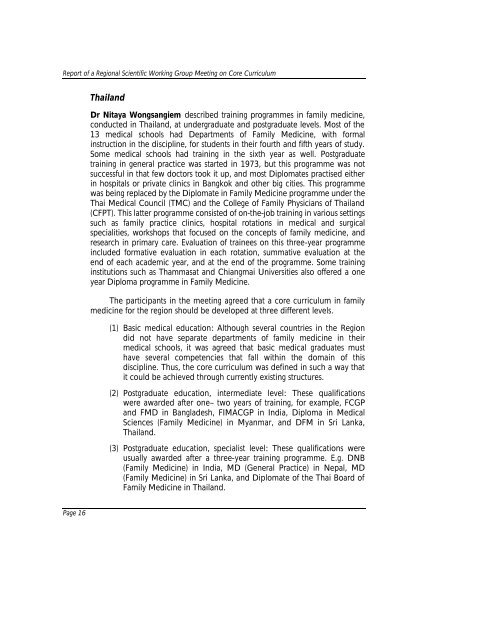Family Medicine
Family Medicine
Family Medicine
You also want an ePaper? Increase the reach of your titles
YUMPU automatically turns print PDFs into web optimized ePapers that Google loves.
Report of a Regional Scientific Working Group Meeting on Core Curriculum<br />
Page 16<br />
Thailand<br />
Dr Nitaya Wongsangiem described training programmes in family medicine,<br />
conducted in Thailand, at undergraduate and postgraduate levels. Most of the<br />
13 medical schools had Departments of <strong>Family</strong> <strong>Medicine</strong>, with formal<br />
instruction in the discipline, for students in their fourth and fifth years of study.<br />
Some medical schools had training in the sixth year as well. Postgraduate<br />
training in general practice was started in 1973, but this programme was not<br />
successful in that few doctors took it up, and most Diplomates practised either<br />
in hospitals or private clinics in Bangkok and other big cities. This programme<br />
was being replaced by the Diplomate in <strong>Family</strong> <strong>Medicine</strong> programme under the<br />
Thai Medical Council (TMC) and the College of <strong>Family</strong> Physicians of Thailand<br />
(CFPT). This latter programme consisted of on-the-job training in various settings<br />
such as family practice clinics, hospital rotations in medical and surgical<br />
specialities, workshops that focused on the concepts of family medicine, and<br />
research in primary care. Evaluation of trainees on this three-year programme<br />
included formative evaluation in each rotation, summative evaluation at the<br />
end of each academic year, and at the end of the programme. Some training<br />
institutions such as Thammasat and Chiangmai Universities also offered a one<br />
year Diploma programme in <strong>Family</strong> <strong>Medicine</strong>.<br />
The participants in the meeting agreed that a core curriculum in family<br />
medicine for the region should be developed at three different levels.<br />
(1) Basic medical education: Although several countries in the Region<br />
did not have separate departments of family medicine in their<br />
medical schools, it was agreed that basic medical graduates must<br />
have several competencies that fall within the domain of this<br />
discipline. Thus, the core curriculum was defined in such a way that<br />
it could be achieved through currently existing structures.<br />
(2) Postgraduate education, intermediate level: These qualifications<br />
were awarded after one– two years of training, for example, FCGP<br />
and FMD in Bangladesh, FIMACGP in India, Diploma in Medical<br />
Sciences (<strong>Family</strong> <strong>Medicine</strong>) in Myanmar, and DFM in Sri Lanka,<br />
Thailand.<br />
(3) Postgraduate education, specialist level: These qualifications were<br />
usually awarded after a three-year training programme. E.g. DNB<br />
(<strong>Family</strong> <strong>Medicine</strong>) in India, MD (General Practice) in Nepal, MD<br />
(<strong>Family</strong> <strong>Medicine</strong>) in Sri Lanka, and Diplomate of the Thai Board of<br />
<strong>Family</strong> <strong>Medicine</strong> in Thailand.









